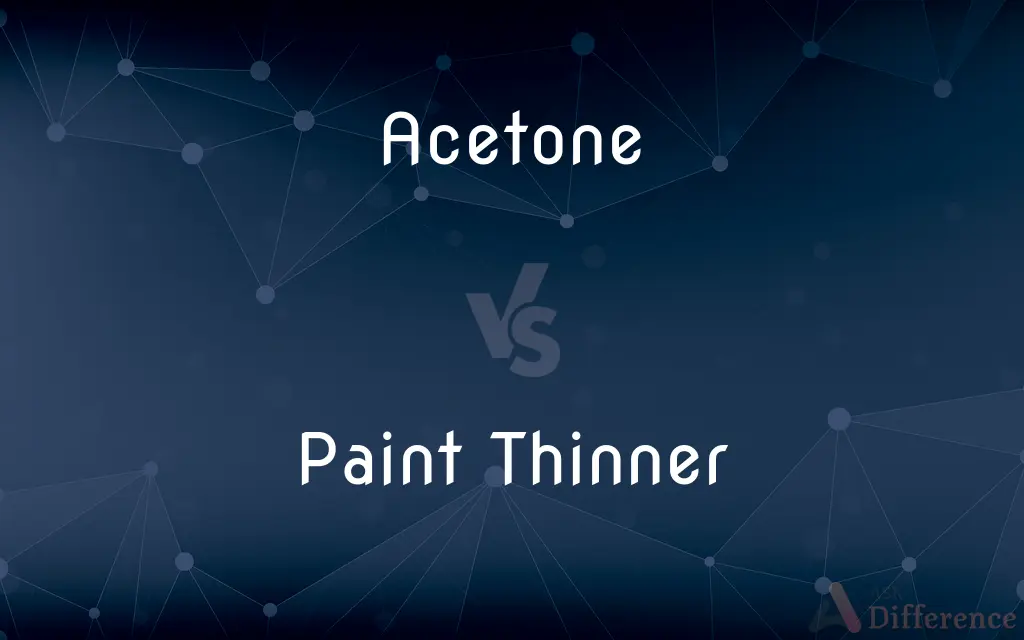Acetone vs. Paint Thinner — What's the Difference?
By Fiza Rafique & Urooj Arif — Published on March 6, 2024
Acetone is a fast-evaporating, potent solvent used in various industrial applications and nail polish remover, while paint thinner is a blend of solvents designed to thin paints and clean painting equipment, generally less potent than acetone.

Difference Between Acetone and Paint Thinner
Table of Contents
ADVERTISEMENT
Key Differences
Acetone is known for its efficiency in quickly dissolving or thinning products such as nail polish, plastics, and resins. It's a colorless, highly volatile, and flammable liquid with a distinctive sweetish odor. Its fast evaporation rate makes it useful in applications requiring quick drying, though its potency means it can damage sensitive materials like plastics and synthetic fabrics.
Paint thinner, on the other hand, is a generic term for a mixture of solvents, such as mineral spirits, that are used primarily to thin oil-based paints or clean up after their use. It is less aggressive than acetone, making it safer for a wider range of materials, though it evaporates more slowly and might not dissolve as wide a range of substances.
Acetone can act as a paint thinner, while its strong solvent properties and rapid evaporation rate mean it's often too harsh for some painting applications, potentially damaging the paint or the surface being painted. Paint thinner, tailored specifically for thinning and cleanup tasks related to painting, offers a gentler alternative that minimizes the risk of such damage. Its composition can vary, including lighter solvents like mineral spirits, which are less effective on hard-to-dissolve substances but better suited for delicate tasks.
Both solvents are used in DIY and professional settings for cleaning and preparation tasks, but their suitability depends on the material and the specific requirements of the job. Acetone's strength and speed make it ideal for quickly removing substances like epoxy or cleaning metal surfaces, while paint thinner's milder nature makes it better for cleaning brushes or thinning paint without affecting the underlying material adversely.
In terms of health and safety, both chemicals require careful handling. Acetone's rapid evaporation can lead to high concentrations in the air, posing inhalation risks, while paint thinner's slower evaporation rate might reduce immediate exposure risks but prolongs the duration of potentially harmful fumes. Proper ventilation and protective gear are essential when using either solvent to mitigate health risks.
ADVERTISEMENT
Comparison Chart
Composition
Single compound (C3H6O)
Mixture of solvents (e.g., mineral spirits, turpentine)
Evaporation Rate
Fast
Slower than acetone
Solvency Power
High
Moderate to high (depends on the mixture)
Applications
Nail polish remover, cleaning strong adhesives, thinning plastics/resins
Thinning oil-based paints, cleaning brushes and equipment
Potency
Potent, can damage sensitive materials
Generally less potent, safer for a wider range of materials
Odor
Strong, sweetish
Varies, generally less pungent than acetone
Flammability
Highly flammable
Flammable
Health Risks
High inhalation risk due to rapid evaporation
Varies, generally lower immediate risk than acetone
Compare with Definitions
Acetone
A potent, fast-evaporating solvent used widely in industrial and cosmetic applications.
She used acetone to remove her nail polish effortlessly.
Paint Thinner
Generally safer and less aggressive than acetone, suitable for a broad range of materials.
Using paint thinner, she cleaned her brushes without damaging the bristles.
Acetone
Highly flammable and requires careful handling and storage.
He stored the acetone in a cool, well-ventilated area away from flames.
Paint Thinner
A solvent mixture designed to thin oil-based paints and clean equipment.
He added paint thinner to his oil paint to achieve the right consistency.
Acetone
Requires protective gear to mitigate health risks when used in large quantities.
Wearing gloves and a mask, she used acetone to clean the tools.
Paint Thinner
Slower evaporation rate than acetone, reducing the risk of rapid inhalation.
The paint thinner took longer to dry, allowing for easier cleanup.
Acetone
Known for its ability to quickly dissolve substances like plastics and synthetic fibers.
Acetone is often used to clean surfaces before painting.
Paint Thinner
Contains a blend of solvents like mineral spirits for versatile use.
The paint thinner's mild odor made it easier to work indoors.
Acetone
Can cause damage to sensitive materials upon contact.
Accidental spills of acetone damaged the plastic countertop.
Paint Thinner
Used in both professional and DIY painting projects for its effectiveness and safety.
For his DIY project, he chose paint thinner to clean up spills and equipment.
Acetone
A colorless, volatile, extremely flammable liquid ketone, C3H6O, widely used as an organic solvent. It is one of the ketone bodies that accumulate in the blood and urine when fat is being metabolized.
Acetone
(organic compound) A colourless, volatile, flammable liquid ketone, (CH3)2CO, used as a solvent.
Acetone
A volatile liquid consisting of three parts of carbon, six of hydrogen, and one of oxygen; pyroacetic spirit, - obtained by the distillation of certain acetates, or by the destructive distillation of citric acid, starch, sugar, or gum, with quicklime.
Acetone
The simplest ketone; a highly inflammable liquid widely used as an organic solvent and as material for making plastics
Common Curiosities
How can I minimize health risks when using these solvents?
Use in a well-ventilated area, wear appropriate protective gear, and follow product safety instructions.
Can acetone and paint thinner be used interchangeably?
While both can be used for similar purposes, their differences in potency and material compatibility make it essential to choose the right solvent for the job.
Which is better for thinning epoxy resins, acetone or paint thinner?
Acetone is generally preferred for thinning epoxy resins due to its strong solvency power.
How should I safely dispose of acetone or paint thinner?
Both should be disposed of according to local hazardous waste regulations to prevent environmental harm and health risks.
Are there any materials that neither acetone nor paint thinner should be used on?
Both solvents can damage sensitive materials like certain plastics, rubber, and synthetic fabrics; always test on a small area first.
Can I use paint thinner to remove nail polish?
Paint thinner is not recommended for use on skin or nails as it's formulated for paint-related tasks and may contain harsher solvents.
What precautions should I take when storing these solvents?
Store in a cool, well-ventilated area away from heat sources, flames, and direct sunlight in properly labeled, sealed containers.
Can either solvent be used to clean wood surfaces before painting?
Paint thinner is generally safer for cleaning wood surfaces, but always test a small, inconspicuous area first.
Is acetone more harmful than paint thinner?
Acetone poses higher immediate health risks due to its rapid evaporation and potency, but both chemicals require proper safety precautions.
Can paint thinner remove adhesives like acetone?
Paint thinner can remove some adhesives, but its effectiveness depends on the adhesive's composition.
Can I dilute acrylic paint with acetone or paint thinner?
Acetone is not suitable for acrylic paints; water or specific acrylic mediums are preferred. Paint thinner is for oil-based paints and may not be compatible with acrylics.
Is it safe to pour acetone or paint thinner down the drain?
No, both should be disposed of as hazardous waste to avoid damaging plumbing and harming the environment.
Are there any natural or less toxic alternatives to these solvents?
For some applications, natural solvents like citrus-based removers may be effective, though they are generally less potent.
Do acetone and paint thinner have the same impact on indoor air quality?
Both can affect indoor air quality, but acetone's rapid evaporation can lead to higher concentrations in the air if not properly ventilated.
How do I know which solvent to use for a specific project?
Consider the material, the solvent's properties, and the project requirements. When in doubt, consult the product's instructions or a professional.
Share Your Discovery

Previous Comparison
5w30 vs. 10w30
Next Comparison
Alignment vs. BalancingAuthor Spotlight
Written by
Fiza RafiqueFiza Rafique is a skilled content writer at AskDifference.com, where she meticulously refines and enhances written pieces. Drawing from her vast editorial expertise, Fiza ensures clarity, accuracy, and precision in every article. Passionate about language, she continually seeks to elevate the quality of content for readers worldwide.
Co-written by
Urooj ArifUrooj is a skilled content writer at Ask Difference, known for her exceptional ability to simplify complex topics into engaging and informative content. With a passion for research and a flair for clear, concise writing, she consistently delivers articles that resonate with our diverse audience.
















































